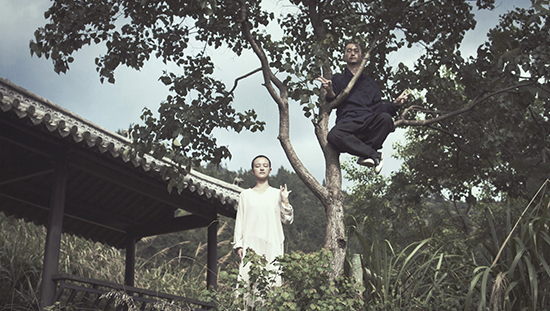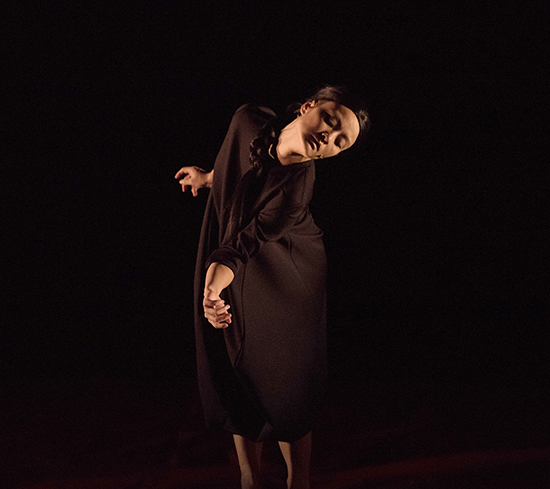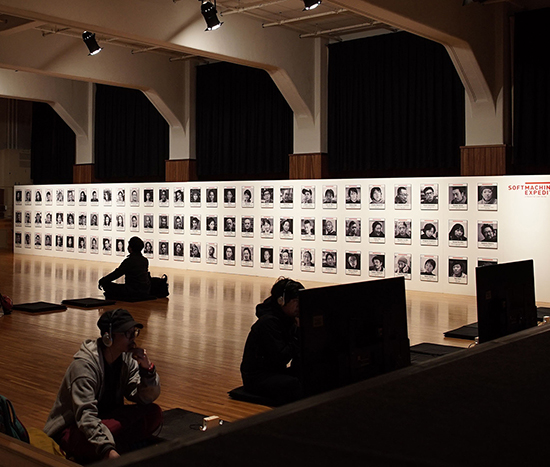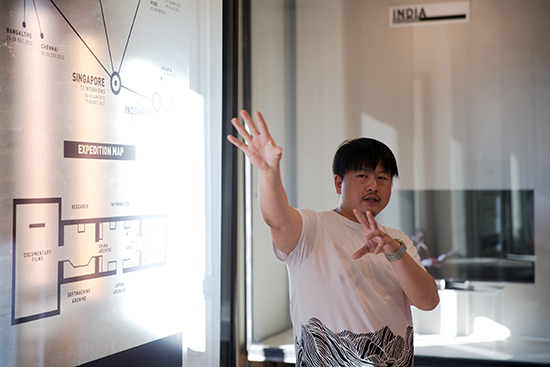The artist, cultural transmitter & trickster
Keith Gallasch: interview, Choy Ka Fai, SoftMachine

Xiao Ke & Zi Han, SoftMachine
Artist, documenter, provocateur and trickster Choy Ka Fai is fun to talk with. The Singaporean performance-maker, video artist and scientific experimenter tells me there’s plenty of humour in SoftMachine, his very serious four-part project about dance in Asia of which we, and many Asians too, may be unaware. Two of its performances are in this year’s Liveworks, one of them, SoftMachine: Rianto, appeared in the recent OzAsia Festival; the other is by Chinese artists XioaKe x ZiHan.
You can witness Choy’s enthusiasm in a TEDx demonstration of Prospectus for a Future Body in which he transfers movements from one body to another by means of electrical mapping of muscles, using himself to learn (or be conditioned) to reproduce a fragment of movement seen in a 1973 film of a performance by Butoh founder Tatsumi Hijikata. From such experimentation he’d like to produce a library of dance movement data. And there are wilder ambitions. He calls this work “pseudo-scientific” but there’s some real science in it and, above all, it’s playful. It pays to attend to the trickster (see Lewis Hyde’s wonderful Trickster Makes His World, 1995).
SoftMachine is also about the transmission of cultural knowledge, but without the shocks. It too shifts between formal investigation, a survey of Asian dance in this case, and an intuitive, artistic response. I spoke by Skype with Choy who was in London with SoftMachine at Sadlers Wells just before coming to Liveworks, asking him about the motivation for and the scope of the work and with a focus on XioaKe x ZiHan.
SoftMachine: dance spy
On a search to find out more about dance in Asia, Choy says he “inserted” himself into cities, seeking out work he hadn’t previously seen, not “underground”—he doesn’t like the word—but “a little underground.” He interviewed 88 artists in four countries: India, Japan, Indonesia and China. “Now, I call myself a contemporary dance spy of Asia.” The idea was to find in each an artist with whom he could establish a deep relationship in order to work together and possibly collaborate in performance. The initial medium was the interview.
“Through conversation you understand how open or generous our communication might be. I might like someone a lot and think their work is fantastic but we can’t really communicate. So in that sense there’s a lot of coincidence. [Finding an artist] is like the Butterfly Effect. When you know someone, they’ll recommend someone else.”
The result is a set of four discrete performances that entail the interplay of dance and documentary film and do honour to the familial, social and cultural contexts in which each of these idiosyncratic artists make their work.
“In each place it began with me trying to understand the ecology of what’s happening in the city through talking with some 20 people. Of course, it’s actually quite intuitive. When I saw Rianto, I could immediately could see it was very possible we could work together. For the Chinese piece, I actually had another artist in mind, much more established and of an older generation. But Xioa Ke and Zihan (who perform as XioaKe x ZiHan) are my age; so is the Japanese choreographer in SoftMachine, Yuya Tsukahara. I thought, this time maybe the work is about my peers. I had met them through an interview in Shanghai in, I think, 2013 and then half a year later after completing all the interviews I decided Xiao Ke would be the best choreographer to work with.”
Shanghai-based Xaio Ke trained in traditional Chinese dance as a child. In 2005 she was co-founder of the Niao ZuHe Physical Theater Company, winner of the 2006 Zurich Theater Spectacle. In 2007 she founded the UGLY Performing Art Center in Beijing. In 2011, with Zhou Zihan and Zhang Yuan, she co-founded the Can not Help Artists’ Collective, focusing on transboundary artforms and social issues. Her collaborator Zhou ZiHan is a sound artist and performer who began his career as a photographer and founded, in 2008, the independent art centre Canart for which he curated contemporary art exhibitions and performances. He and Xiao Ke, as XiaoKe x ZiHan, combine dance, photography, video, live art and installation.
Catch XiaoKe x ZiHan in conversation and in rehearsal here and performing the Tibetan folk song-cum-propaganda The Laundry Song.
Choy tells me, “The Chinese work in SoftMachine is one of the most ‘insecure’ pieces I’ve made. We became very good friends quite fast whereas with Yuya Tsukahara we’d been working together since 2009 in a different capacity. With Surjit Nongmeikapam and Rianto, the Indian and Indonesian artists, we’d had a two-month residency in Bangalore. So we had already established our friendship before we started to become colleagues. Rianto had an interesting story to tell and he has a very clear dance form. But these Chinese artists are multi-disciplinary, they do a lot of different things: live art, multimedia, social theatre, site-specific and durational performance… When I first saw their work, I thought they were doing what [was being done in live art] five to 10 years ago in London, but in a different context.”
Another reason for insecurity occurred when one of the artist’s close friends, says Choy, “was invited to ‘have tea’ at the Cultural Bureau of China, meaning the cultural police were watching him.” Others received similar invitations. There was a growing suspicion that there was a spy in Xioa Ke and Zhou Zihan’s network of friends. It was, Choy Ka Fai says, an unsettling month for the collaboration. It became an issue about the “the boundary of freedom which I’ve experienced a little as a Singaporean artist as a sense of self-censorship. So we turned this whole Shanghai experience into a performance.”
“On another level I was insecure,” he adds, “because I think in the Chinese work I gave away a lot of control as a director because we trust each other a lot and there’s a lot of not-misunderstanding, a lot of give and take. With these artists if I say, ‘please do this,’ they might not agree. If you’re a very good friend, you can do that and it’s not personal. It’s a really true collaboration in that sense. Conceptually, they are very clear what they want to do and can be quite eccentric as well. They travel a lot to Europe now. They brought with them two 60-year-old Chinese grandmothers who did a public dance—because after dinner people in China dance in public squares. They taught German grannies to do it in a little bit of participatory work. So I think XiaoKe x ZiHan really are, you could say ‘not focused’ because they’re trying to do so much.” (LAUGHS).

SoftMachine: Xiaoke x Zihan, Choy Ka Fai
The artist as performer
I ask Choy about how he arrived at his fascination with dance, such that he would create a work on the scale of SoftMachine with its blend of conversation, process, performance and documentation.
“I started as a physical theatre practitioner when I was 18 and then I saw the performance group Dumbtype from Japan and decided I wanted to make art. In a way I’m always looking at the different extensions of the body in performance. What Dumbtype did in the 80s and 90s was amazing; in a way it was like total theatre. Everything comes together. Then I went on to study video art but continued making performance [he was an Associate Artistic Director of Singapore’s Theatreworks 2007-09 and had worked with Ong Keng Sen since 2004] and performed myself a little bit. In SoftMachine I appear in two of the pieces, but sadly these are not showing in Sydney. In the Indian piece I’m the investigator and also a pseudo-academic (shown here) who’s trying to teach an Indian how to perform Indian dance for a European audience.
“The Japanese piece, because Yuya Tsukahara and I knew each other for a long time, is the most physically demanding piece I’ve made in the last decade. It [involves] a form of contact improvisation. The premise for the piece was that I wanted to put myself in the shoes of someone who wants to become a member of his group Gonzo from Osaka. I ask Yuya to teach me and I interview him at the same time. But with Rianto it’s very clear that it’s possible for me to do anything on stage, even take away attention from him (LAUGHS). So that’s why I’m not onstage.”
Nor is he onstage with ZioaKe x Zihan, “We had a part where the three of us dance together—but then the dramaturg said, ‘it’s quite messy.’”

SoftMachine exhibition, Choy Ka Fai
At the point of origin
I ask if, as in the other works in SoftMachine, there is a focus with XioaKe x ZiHan on the places they’ve grown up in and the audiences they perform to. “With all of the pieces I try to have it performed in the place of origin, the city or country the artists live in, before touring, to get a response because the work is so closely related to the environment and the society. With the Chinese piece there’s a lot of material about their everyday life in Shanghai and a little bit from their personal history. For instance, I didn’t know that Xiao Ke was a member of the Chinese Communist Party when she was at university. She studied journalism and so she had to be a member to be a journalist. Things like that surprised me. We didn’t get a license to perform publicly so we had a closed door event at the Shanghai Dramatic Centre during a festival.
“Through the interviews, one of the surprising findings came when I asked Chinese artists, ‘Who do you think is the artist that best represents Chinese contemporary dance?’ And they would say it’s Cloudgate from Taiwan. Because they think the Taiwanese took all of China’s museum artefacts to Taiwan, they always look to Cloudgate because it has evolved from Chinese dance and martial art forms. That too was quite surprising for me.”
Having toured SoftMachine performances in Asia and to Europe and Australia and staged an accompanying exhibition (showing in Liveworks), Choy Ka Fai hopes to make all the material available online. He has no immediate plans to add to SoftMachine but is tempted by Central Asia. A significant challenge, he says, is language. “In Indonesia I had to rely on the translator, who is a close friend, to find information [about choreographers]. It’s a problem but also the beauty of Asia. You see, there are things that you can’t really understand. In Indonesia in the interviews everyone was talking about ‘Rasa’ in contemporary dance and I asked so many people, ‘How do you define it? Is it a spirit or a presence?’ That’s one of the things I thought SoftMachine can do, to share knowledge.”
The Dance Doctor
I ask Choy Ka Fai about his work on dance in the neuroscience domain. He tells me, “There’s a lot about technology that interests me. I’ve been working on and off on it for almost two years now. Next year I’ll finally be pushing out Dance Clinic. The idea is very simple. There’s often a gap between what a choreographer writes about their dance work and what an audience sees. I wonder if this can be understood by analyzing choreographers’ brainwaves. I’m trying to be a dance doctor, using neuroscience and a pseudo-scientific device to tell you what your brain is really thinking. I call it ‘a life consultation.’ My Dance Clinic will tour the world collecting data and building an algorithm with which to create an AI choreographer.” A two-year residency at Tanzhaus NRW, Dusseldorf will further the project.
“In analyzing brainwaves I’m also interested in looking at whether the performer or dancer is present or absent (read an interview about this)—I’m very much inspired by Marina Abramovic’s performance The Artist is Present.”
I comment that the project appears to be half-serious. Choy thinks it’s more serious than that, but says, “I think it’s the position I want to take because, in terms of an art/science collaborations, when a scientist takes the lead it becomes an academic paper—like, 400 pages that I don’t understand. But when an artist takes the lead, a lot of the interesting science is lost because, at the end of the day, they want to put something beautiful on stage. So I’m trying to be in-between; it’s common sense to me, in the sense of public science.
I ask if Choy will be in Sydney for Liveworks. “Yes, I’ll be here throughout and I’ll be working at Critical Path on a documentary project for 2017 in Japan about Butoh called Unbearable Darkness. Next year I’ll be at Campbelltown Arts Centre as well.” An ongoing exchange of ideas with Choy Ka Fai could be invaluable for futhering the hitherto slow growth of a relationship between Australian and Asian dance that is both culturally informative and experimentally minded.

Choy Ka Fai at SoftMachine exhibition InPulsTanz 2015
Read Ben Brooker’s review of SoftMachine: Rianto.
Performance Space, Liveworks Festival of Experimental Art: Choy Ka Fai, SoftMachine: Rianto; SoftMachine: XioaKe x ZiHan; Carriageworks, Sydney, both works 27-30 Oct
RealTime issue #135 Oct-Nov 2016






